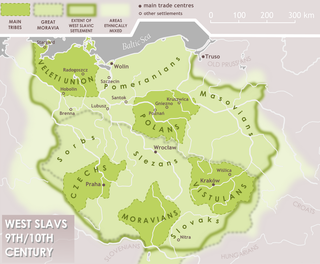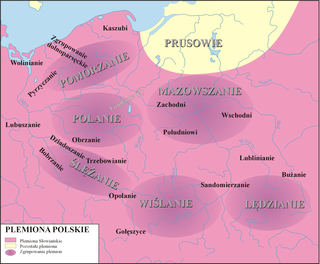
The river Warta rises in central Poland and meanders greatly north-west to flow into the Oder, against the German border. About 808.2 kilometres (502.2 mi) long, it is Poland's second-longest river within its borders after the Vistula, and third-longest in total length. Its drainage basin covers 54,529 square kilometers (21,054 sq mi) and it is navigable from Kostrzyn nad Odrą to Konin, approximately half of its length. It is connected to the Vistula by the Noteć and the Bydgoszcz Canal near the city of Bydgoszcz.

The Poles, also referred to as the Polish people, are a West Slavic ethnic group and a nation native to Poland in Central Europe, who share a common Polish ancestry, history, and culture and are speakers of the Polish language.

The Cherven Cities or Cherven Grods, often literally translated as Red Cities, Red Forts or Red Boroughs, was a point of dispute between the Kingdom of Poland and Kievan Rus' at the turn of 10th and 11th centuries, with both sides claiming their rights to the land.

Podlachia or Podlasie, is a historical region in the eastern part of Poland. Between 1513 and 1795 it was a voivodeship with the capital in Drohiczyn. Now the part north of the Bug River is included in the modern Podlaskie Voivodeship with the capital in Białystok.

The West Slavic languages are a subdivision of the Slavic language group. They include Polish, Czech, Slovak, Kashubian, Upper Sorbian and Lower Sorbian. The languages are spoken across a continuous region encompassing the Czech Republic, Slovakia and Poland as well as the former East Germany and the westernmost regions of Ukraine and Belarus.

The Polans, also Polianians, were an East Slavic tribe between the 6th and the 9th century, which inhabited both sides of the Dnieper river from Liubech to Rodnia and also down the lower streams of the rivers Ros', Sula, Stuhna, Teteriv, Irpin', Desna and Pripyat. In the Early Middle Ages there were two separate Slavic tribes bearing the name of Polans, the other being the western Polans, a West Slavic tribe.

The Western Polans were a West Slavic and Lechitic tribe, inhabiting the Warta River basin of the contemporary Greater Poland region starting in the 6th century. They were one of the main tribes in Central Europe and were closely related to the Vistulans, Masovians, Czechs and Slovaks.

Silesians is a geographical term for the inhabitants of Silesia, a historical region in Central Europe divided by the current national boundaries of Poland, Germany and the Czech Republic.
An endonym is a common, internal name for a geographical place, group of people, or a language/dialect, that is used only inside that particular place, group, or linguistic community in question; it is their self-designated name for themselves, their homeland, or their language.

"Polish tribes" is a term used sometimes to describe the tribes of West Slavic Lechites that lived from around the mid-6th century in the territories that became Polish with the creation of the Polish state by the Piast dynasty. The territory they lived on became a part of the first Polish state created by duke Mieszko I and expanded at the end of the 10th century, enlarged further by conquests of king Bolesław I at the beginning of the 11th century.

In this time period Polish history covering roughly a millennium, from the 5th century, the way through to the 16th century. It is commonly dated from the fall of the Western Roman Empire, and contrasted with a later Early Modern Period; the time during which the rise of humanism in the Italian Renaissance and the Reformation unfolded, are generally associated with the transition out of the Middle Ages, with European overseas expansion as a succeeding process, but such dates are approximate and based upon nuanced arguments.

The Vistulans, or Vistulanians, were an early medieval Lechitic tribe inhabiting the western part of modern Lesser Poland.

The West Slavs are a subgroup of Slavic peoples who speak the West Slavic languages. They separated from the common Slavic group around the 7th century, and established independent polities in Central Europe by the 8th to 9th centuries. The West Slavic languages diversified into their historically attested forms over the 10th to 14th centuries.
The Lendians were a Lechitic tribe who lived in the area of East Lesser Poland and Cherven Towns between the 7th and 11th centuries. Since they were documented primarily by foreign authors whose knowledge of Central and East Europe geography was often vague, they were recorded by different names, which include Lendzanenoi, Lendzaninoi, Lz’njn, Lachy, Landzaneh, Lendizi, Licicaviki and Litziki.

Lechites, also known as the Lechitic tribes, is a name given to certain West Slavic tribes, which inhabited modern-day Poland and were speakers of the Lechitic languages. Distinct from the Czech–Slovak subgroup, they are the closest ancestors of ethnic Poles and the extinct Pomeranians and Polabians.

Silesians were a tribe of West Slavs, specifically of the Lechitic/Polish group, inhabiting territories of Lower Silesia, near Ślęża mountain and Ślęza river, on the both banks of the Oder, up to the area of modern city of Wrocław. They were the first permanent inhabitants of the site of Wrocław where they build a fort on Ostrów Tumski in the 9th century or earlier, which at the time was an island on the Oder.

The most important phenomenon that took place within the lands of Poland in the Early Middle Ages, as well as other parts of Central Europe was the arrival and permanent settlement of the West Slavic or Lechitic peoples. The Slavic migrations to the area of contemporary Poland started in the second half of the 5th century AD, about a half century after these territories were vacated by Germanic tribes fleeing from the Huns. The first waves of the incoming Slavs settled the vicinity of the upper Vistula River and elsewhere in the lands of present southeastern Poland and southern Masovia. Coming from the east, from the upper and middle regions of the Dnieper River, the immigrants would have had come primarily from the western branch of the early Slavs known as Sclaveni, and since their arrival are classified as West Slavs and Lechites, who are the closest ancestors of Poles.
National symbols of Poland are the tangible and intangible symbols, emblems or images that are found in Poland to represent the country's unique customs, traditions, cultural life and its 1000-year history. These symbols serve as the nation's portrayal of patriotism and dedication to their national identity. The Polish people and the Polish diaspora around the world take great pride in their native country, and associate themselves with the colours white and red. The expression biało-czerwoni ("whitereds") is widely used by Poles when referring to their compatriots. A crowned white-tailed eagle on a red shield or background has been Poland's national symbol and coat of arms since the Middle Ages. Other unofficial symbols feature visual personifications, music of Chopin, polka and polonaise dances, animals such as the European bison or the white stork, apples, red poppy flowers and religious insignia of the Roman Catholic church. Several have been popularised in recent years, notably the winged hussars.
Lach, Lyakh or Ljach is a surname. It was used by East Slavs to refer to Poles. Ethnic Poles in Nowy Sącz also used the name, referring to themselves as Lachy Sądeckie. According to Paweł Jasienica, it derives from the name of an ancient Polish tribe, the Lendians. Due to population resettlements of ethnic Poles after the Soviet annexation of eastern Polish territories, it is slightly more frequent in western Poland. Over 10,000 people have this surname in Poland. In the Czech Republic and Slovakia, Lach served as a short form of the personal name Ladislav. It is also a variant of Lah, a Slovene word for Vlachs.
In the contemporary English language, the nouns Polack or Polak are ethnic slurs, and derogatory references to a person of Polish descent. It is an Anglicisation of the Polish masculine noun Polak, which denotes a person of Polish ethnicity and male gender. However, the English loanword is considered by some to be an ethnic slur and therefore considered insulting in certain contemporary usages.



















